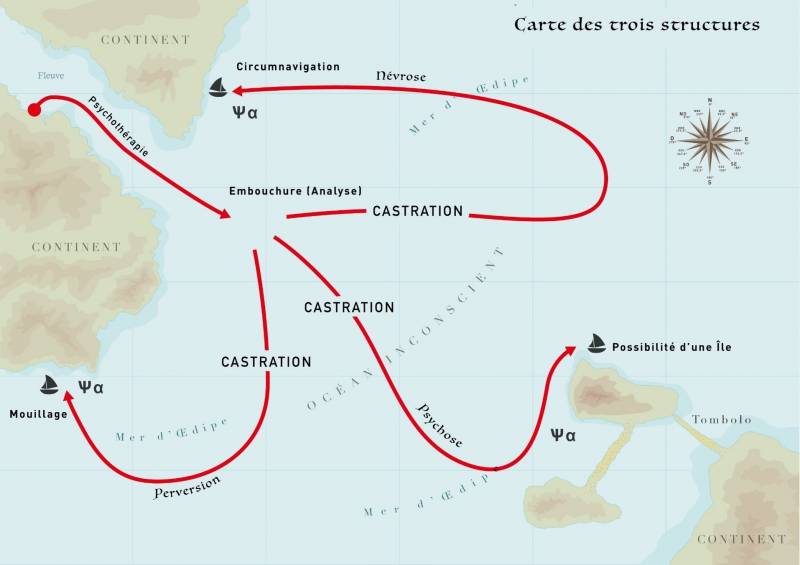Map of the three structures
Map of the three structures
March, 18, 2019
Map of the three structures A maritime route, unlike a land route, is an itinerary that cannot be materialized. It requires the use of cartographies and references based on currents and winds and birds. The reader will note I use references to sailing ships used on rivers and oceans over a period stretching from the first navigators (Columbus in 1492 who landed in the West Indies, Vasco de Gama who reached India in 1498 and Magellan, Elcano rather, who made the first voyage around the world in 1519) up to the beginning of the steamship era, that is to say in 1776, with the Palmipède developed by Frenchman Claude François Jouffroy d’Abbans.
The map I propose of the clinical route for the conduct of therapy serves to chart the way for psychoanalysts providing psychotherapies and psychoanalyses with structures such as neurosis, psychosis and perversion. In the top left-hand section of the map a red circle represents the point of departure for psychotherapy with neurotics, psychotics and perverts.(http://www.fernandodeamorim.com/details-carte+des+trois+structures-264.html)
Once the being enters the boat of therapy he leaves the land, represented by the continent. He will travel down the river, representing psychotherapy, up to the river mouth. I was inspired by Magellan’s travels down the Guadalquivir river in September 1519, which enabled him to achieve the first round-the-world voyage in history. The river mouth is the point where the fresh water of psychotherapy meets the salt water of the ocean. This was made evident to me through my reading of the Koran.
When the patient addresses the barred big Other with the question, she leaves the river and enters psychoanalysis, that is to say, she takes to the open sea. The clinician reading should not be surprised by the fact that, for some time, the psycho-analysand’s discourse will be unclear, as if some residue from psychotherapy still remains on the couch, even while the couch is testament to the fact that the being is now in the ocean, in salt water, in psychoanalysis.
This issue is of little importance as the passage from psychotherapy to psychoanalysis will be determined by the question addressed to the big Other. Even if the discursive coloration of psychotherapy (fresh water) lingers on during psychoanalysis, we have proof of entry into psychoanalysis (salt water) through the question addressed to the barred big Other. If we are dealing with a neurotic, he will push the therapy forwards — through the oar strokes performed with each utterance of his free associations and each of the psychoanalyst’s scansions. These two processes testify to the fact that it is castration that pushes the boat of therapy towards the sea of Oedipus, a sea conceptualized by the author of the present text in order to state that no speaking being — whatever his age, color or faith ¬— escapes his Oedipus, and resolving it is central to the speaking being’s life as the possibility of beginning life resides therein. The end of psychoanalysis is a kind of second birth. While the first is real, the second is symbolic. It is what the being does on approaching the sea of Oedipus that will mark the specificity of her structure and its relation to castration. In this way, as the therapy advances she will move closer to the sea of Oedipus and will either traverse it, or not.
Crossing the sea of Oedipus is particular to the neurotic structure. If the psycho-analysand reaches land, there will be an end to psychoanalysis and she will effectively occupy the position of subject. Several psychoanalysts have made this trajectory but have given up the position of psycho-analysand. The current and the wind of resistance drew them towards the river mouth. They became analysts.
Now for psychosis.
In psychosis, once the patient with a psychotic structure addresses the barred big Other with the question, he enters psychoanalysis and will make his journey in a specific context for he is now on the couch. It is important the psychoanalyst proceed with caution — not interpreting or scanding as if one were dealing with a neurotic or a pervert. It is contraindicated to end a session with a psychotic in the manner commonly practiced with a neurotic.
The end of a session with a psychotic should come two or three sentences after the psychoanalyst has identified the point at which to scand the session, thus marking the end of the session. The aim is that the psychotic be able to create the possibility of an island. The sea of Oedipus has been reached but the psychotic does not cross it. The possibility of an island can, after psychoanalysis, give the impression the psychotic has become a neurotic. This is in no way the case. What we have, instead, is the tombolo effect. The psychotic, on becoming a subject in his relationship to desire, mentally constructs a sound symbolic bridge enabling him to mix with neurotics, to match their behavior, without however having the same ordinariness.
Finally, perversion.
In perverted structures, once the being has addressed the barred big Other with the question, as noted above, she enters psychoanalysis. The patient with a perverted structure does not traverse the Oedipus and does not reach the sea of Oedipus but avoids it. What is important is that the pervert engaged in psychoanalysis is able to create a way of dropping anchor, of mooring up.

